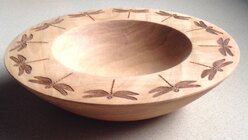So as some may already know, Minwax discontinued their antique oil finish. This was my favorite, which I used almost exclusively. Tung oil doesn't do it for me, and their brand tung oil finish takes several days to dry. I tried adding japan drier to it and it still was tacky after a couple days. This is completely unacceptable for me. It also doesn't have the same amount of shimmer in the woodgrain, which was part of the draw for the antique oil. Waterlox is quite a bit more expensive than the antique oil was. I thought about using a homebrew style varnish with 1 part turpentine, 1 part boiled linseed oil, and one part urethane varnish, but every time I've used it in the past the surface ends up far too glossy for my taste. Even after buffing with white scotchbrite pads. I'm open to suggestions. I have a few bowls ready for sanding and varnishing and only have 1 can of the antique oil left. The first coat I saturate the wood then buff it out with a white scotchbrite pad. I use a lot more finish than most people, but I think I get a lot better shimmer than I can get with urethane or spar varnish. Anyway, I'm needing a replacement and I don't want to just buy a bunch of different, expensive products. I've heard good things about general finishes products, but I'd rather see some results first. Thanks in advance.
Last edited:

